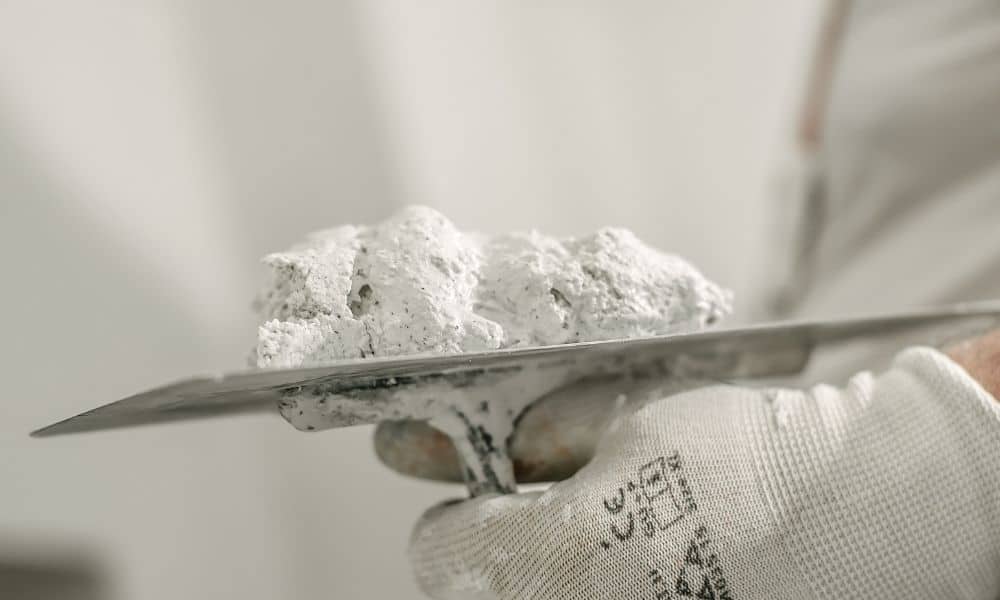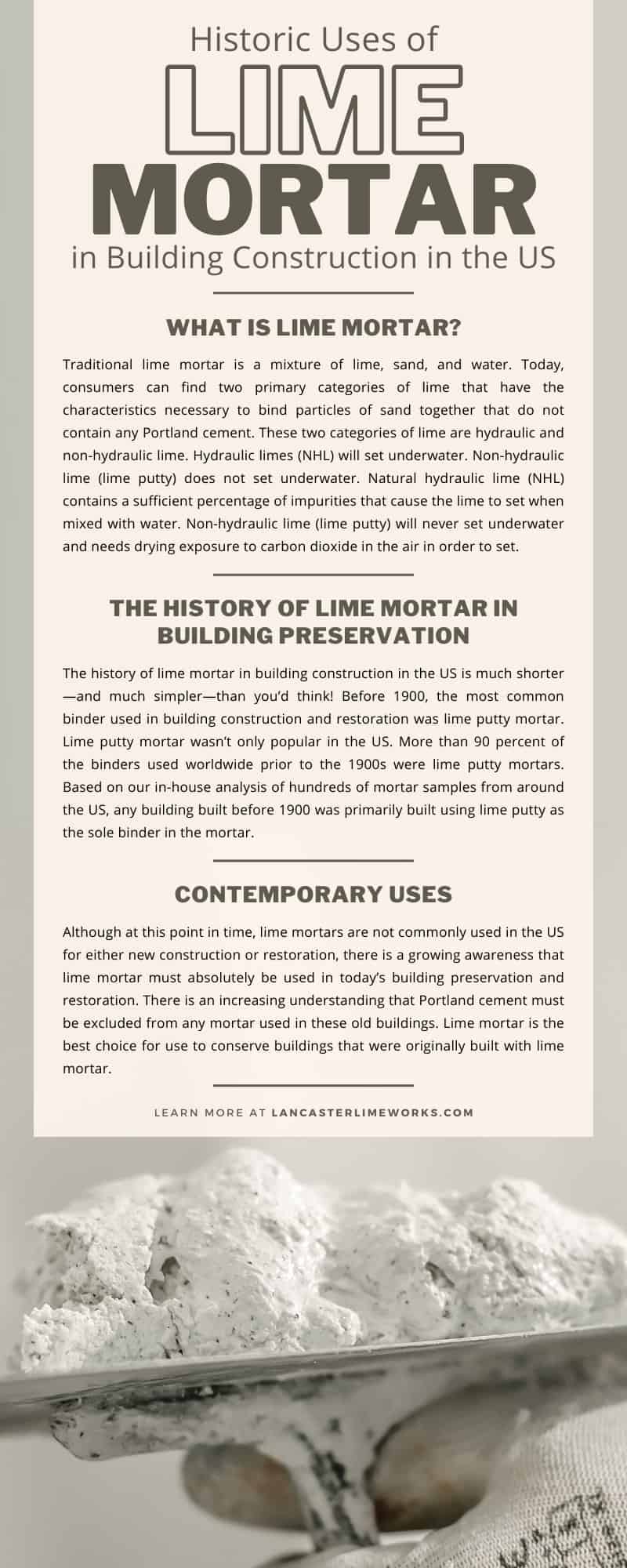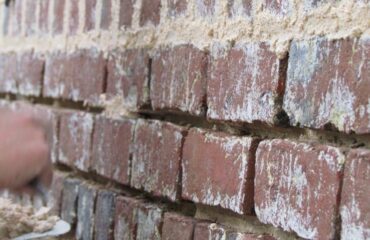When traveling across the eastern coast of the United States, it’s not uncommon to see old, colonial homes in disrepair. They may appear fine at first glance, but when you look closer, you notice cracks, gaps, dusting, missing mortar, and even fully dissolved bricks. As their facades are slowly eaten away, it seems nothing is properly maintained. But why, and how? Given the recent advancements in technology and the invention of modern materials, shouldn’t it be simple to preserve these old historical buildings?
Interestingly enough, while there have been many modern advancements in the mortar world, these modern materials have wreaked havoc when used on historic buildings. Technological advancements and modern materials haven’t improved our ability to preserve old buildings. In fact, they’ve hindered it!
In this brief guide on historic uses of lime mortar in building construction in the US, we’ll delve into a short history of lime mortar use in the US and the reasons why old colonial homes aren’t lasting like they should.
What Is Lime Mortar?
Traditional lime mortar is a mixture of lime, sand, and water. However, as Robert Boynton said, “Lime is not Lime is not Lime.” It is critical that the correct lime be used when making a workable lime mortar. For example, lime used on a farmer’s field will not work as a binder in lime mortar. The correct lime in lime mortar must be able to act as a sole binder with no Portland cement added. Today, consumers can find two primary categories of lime that have the characteristics necessary to bind particles of sand together that do not contain any Portland cement. These two categories of lime are hydraulic and non-hydraulic lime. Hydraulic limes (NHL) will set underwater. Non-hydraulic lime (lime putty) does not set underwater. Natural hydraulic lime (NHL) contains a sufficient percentage of impurities that cause the lime to set when mixed with water. Non-hydraulic lime (lime putty) will never set underwater and needs drying exposure to carbon dioxide in the air in order to set.
When using lime putty and a more durable mortar is required, a pozzolan can be added to it. A pozzolan can be fly ash, silica fume, specialty clay, volcanic ash, or brick dust, which can improve the durability of lime putty mortars and help protect against weathering damage. Historically, lime putty was matured for many years, and this maturing process improves the quality of the putty. When using NHL’s pozzolan is not necessary, the correct durability of the NHL should be chosen. NHL 2.0 is for soft bricks, soft stones, stuccos, and plasters. NHL 3.5 is for harder stones and bricks. NHL 5.0 is for hard stones such as granite and for constantly wet locations such as a below-grade location, skyward facing joints, and bridge abutments.
The History of Lime Mortar in Building Preservation
The history of lime mortar in building construction in the US is much shorter—and much simpler—than you’d think! Before 1900, the most common binder used in building construction and restoration was lime putty mortar. Lime putty mortar wasn’t only popular in the US. More than 90 percent of the binders used worldwide prior to the 1900s were lime putty mortars. Based on our in-house analysis of hundreds of mortar samples from around the US, any building built before 1900 was primarily built using lime putty as the sole binder in the mortar.
But that all changed during the Industrial Revolution when Portland and lime mix became widely available. Originally, Portland cement was only sold by a few companies. But it quickly took off, and before long, companies started mass-producing it. Slowly but surely, lime putty mortar began to fade from the spotlight. In mortars analyzed from the years 1900–1930, we have found a mix of lime putty and Portland cement.
From 1930 until the present time, Portland cement overtook lime putty mortar as the main binder for building and restoration in the US. While lime putty mortar is occasionally used today, most use Portland cement as the binder of choice for both new construction and restoration projects.
While Portland cement has its perks for modern building techniques, namely its quick setting and high compressive strength, it also has numerous downsides. In fact, the use of Portland cement on old historic buildings is one of the main reasons they decay. One problem is that Portland cement is too hard for older buildings that were built using lime mortar and soft bricks. This is because of the principle that mortar must always be softer than the brick or stone it is used with. If the mortar is harder than the brick or stone it is used with, the mortar will damage the building blocks of the building. Portland cement also traps moisture, which leads to gradual and sometimes swift structural decay. This is because lime dissolves when it stays continuously wet or damp. Lime putty mortar, on the other hand, is flexible, porous, and soft enough to move with the historic building. The flexibility of lime putty mortar allows the building to expand and contract without damage. The porosity of the lime putty mortar will not trap moisture in the masonry walls, thus allowing them to dry quickly, which prevents the lime mortar from dissolving.
Contemporary Uses
Although at this point in time, lime mortars are not commonly used in the US for either new construction or restoration, there is a growing awareness that lime mortar must absolutely be used in today’s building preservation and restoration. There is an increasing understanding that Portland cement must be excluded from any mortar used in these old buildings. Lime mortar is the best choice for use to conserve buildings that were originally built with lime mortar. Quality contemporary lime mortars are made from specialty lime, carefully chosen aggregate, and clean water with no added Portland cement, bonding agents, or other modern chemicals. Given that lime mortars cannot work well with Portland cement, traditional low-temperature fired lime mortars offer the best solution for similar existing mortars or reconstruction of buildings that were built using lime mortar.
Lime mortar is also considered a green building material. Lime putty absorbs carbon dioxide in the curing process. Non-hydraulic lime can absorb a significant amount of carbon dioxide, making it a green solution for any building construction or preservation. Lime mortar is also recyclable. You can save historic mortars and plasters by crushing the old plaster, adding fresh lime, and reusing it.
Lancaster Limeworks is the perfect lime mortar supplier for any historic building restoration or conservation project. We produce all our non-hydraulic lime mortar in-house to provide the best building material available. We’re experienced leaders in lime mortar supply who work tirelessly to provide the best solutions for historic and old building restoration. We only sell quality and trustworthy products used and approved by industry professionals for their longevity, strength, and resilience.
Whether you’re a homeowner, tradesman, architect, curator, or engineer, we’ll answer all your masonry questions, from cleaning to custom mortar matches for your specific project. We’ve worked across the Atlantic with Roundtower in Ireland for expertise and knowledge on building preservation to bring back to the US. Call us for more information on our products or consultation services. Lancaster Limeworks is happy to help revitalize your old and historic building with the right lime mortar solution.



Looking at doing a brick restoration tuck point after removal of stucco, approx 5000 sf in Pueblo, Co. Building built 1896. Is there a supplier of your non hydraulic lime mortar in Colorado
We currently do not have any distributors. We can get competitive freight rates. Please feel free to call or text 717-917-6436 with your name, delivery address, quantity, and if you need a liftgate, and we’d be happy to quote you. Thank you!
My house was built in 1906. We moved in in 1995. The basement/foundation had been repointed in areas and painted with drylock sometime prior to buying. Recently we have noticed Spalding bricks with the mortar joints in tact. Is it feasible to remove the mortar and replace it with lime mortar?
Yes, you are correct. The portland cement and the drylock should be removed. These are likely trapping moisture and dissolving the original mortar and causing the bricks to spall. Other considerations are downspouts discharging too close to the foundation and incorrect grading around the building. Grade should have a slope away from the building. If you would like to text us pictures at 717-207-7014, we’ll take a look and offer product and detailed technical advice.